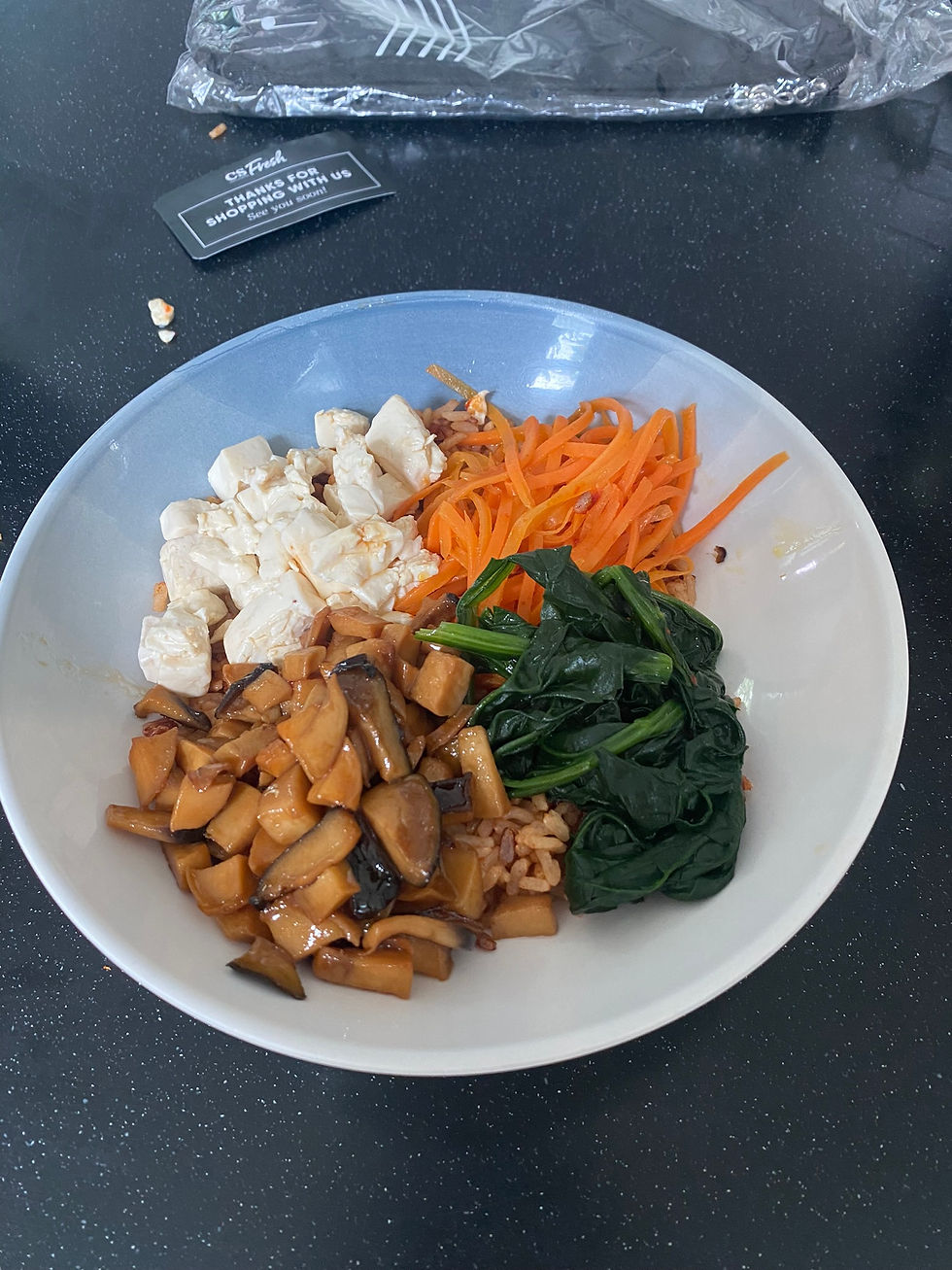
INGREDIENTS:
Rice:
-
2 cups raw brown rice
-
4 cups water
-
1 pinch salt
-
1 tsp gochujang
-
1 tsp sesame oil
Spinach:
-
2 cups raw spinach
-
1 pinch white sesame seeds
Tofu:
-
5 oz extra-firm tofu
-
Extra virgin olive oil
-
1 tsp low-sodium soy sauce
-
½ tsp honey
Carrot:
-
1 small carrot
Mushroom:
-
200g small king oyster mushrooms
-
1 tsp extra virgin olive oil
-
1 pinch salt
Egg:
-
1 egg
-
1 tbsp extra virgin olive oil
NOTE: you can use the same pan to saute and fry everything that needs to be sauteed and fried!
PROCEDURE:
Rice:
-
Wash the rice using a chinois or colander under the tap until the water runs clear
-
Put the rice into the rice cooker
-
Put the water into the rice cooker
-
Add a pinch of salt and stir
-
Press the button on the rice cooker, and prepare the other ingredients as the rice cooker does the work.
Carrots:
-
Peel the carrot
-
Cut the carrot into julienne using a mandolin
-
In a saucepan, heat up 1 teaspoon of olive oil, and very quickly saute the julienned carrots on medium heat for thirty seconds. This allows the body to absorb the nutrients in the carrot easier than if it were completely raw.
-
Finish with a small pinch of salt.
Mushrooms:
-
Wash the king oyster mushrooms. If any are too large, cut into bite-size chunks
-
In the same pan, sauté the mushrooms over medium heat in extra virgin olive oil, until outside is slightly browned and mushrooms are soft. This should take around a minute.
-
Toss with a touch of salt before setting aside.
Tofu:
-
Cut the tofu into half-inch or 1cm cubes.
-
In the same pan, gently place every piece of tofu into olive oil heated to medium-high. Sear one side of tofu until brown and crispy. Do not toss now, as this would break up the tofu.
-
When the side currently searing turns golden-brown, flip the tofu. Repeat until all sides are nicely seared and tofu cubes are crispy.
-
Take finished tofu aside, and drizzle with 1 teaspoon of low-sodium soy sauce and half a teaspoon of honey.
Spinach:
-
In a small saucepan of boiling water, blanch the spinach for twenty seconds, or until it turns soft. Pull it immediately.
-
Drain the spinach well. Then, season lightly with a bit of low-sodium soy sauce and white sesame seeds.
Egg:
-
Heat a small non-stick pan to medium-high with some olive oil
-
Crack an egg and fry until crispy. Season with salt. Make sure you keep the yolk runny
-
Serve
Assembly:
-
After the rice cooks, put some in a large bowl while it is still hot.
-
Then, add half a teaspoon of gochujang and a teaspoon of sesame oil.
-
Mix the rice and seasonings with rice fluffer until seasonings are evenly distributed and every grain of rice is a bit red.
-
Pile the seasoned rice into a large shallow bowl. Then, organize the miscellaneous toppings to finish the bibimbap. Place the egg on top. Serve.
STORY:
Bibimbap is a firm Korean classic. From the finest bibimbap served in hot stone pots in Seoul’s many delicious restaurants, to the low effort, “whatever-is-in-the-fridge” lazy bibimbap made of randomly mixed items, this dish is served across South Korea, and now across the world. While most versions call for a protein, such as ground beef or bulgogi, this vegetarian version is designed to be healthy first and foremost while staying true to Korean traditions and flavors.
Tofu, a common Korean ingredient, has become popular recently across many Western countries due to its low-calorie, high-protein profile. The healthy properties of this ingredient are part of the reason why high-income East Asian countries, like Japan, Korea, Taiwan, and Hong Kong, have some of the longest life expectancies in the world.
In addition, this recipe pieces together a colorful array of mixed vegetables, which contain a beautiful variety of nutrients to nourish the body. Last but not least, everything is tied with a perfectly-fried crispy egg, to add a bit of protein, while the yolk binds with the rest of the food to form the perfect sauce.
This recipe calls for brown rice instead of white rice. Brown rice has more fiber, antioxidants, and vitamins than white rice, which can help maintain blood sugar levels and keep a consistent weight. You can also opt to use white rice for a cleaner and more fragrant appearance, or for something easier to digest. Both are delicious, however.


BIBIMBAP
Bibimbap is a typical Korean food whose health benefits cross all geographical boundaries. This dish consists of rice, stir-fried vegetables, gochujang (Korean chili paste), and usually protein.